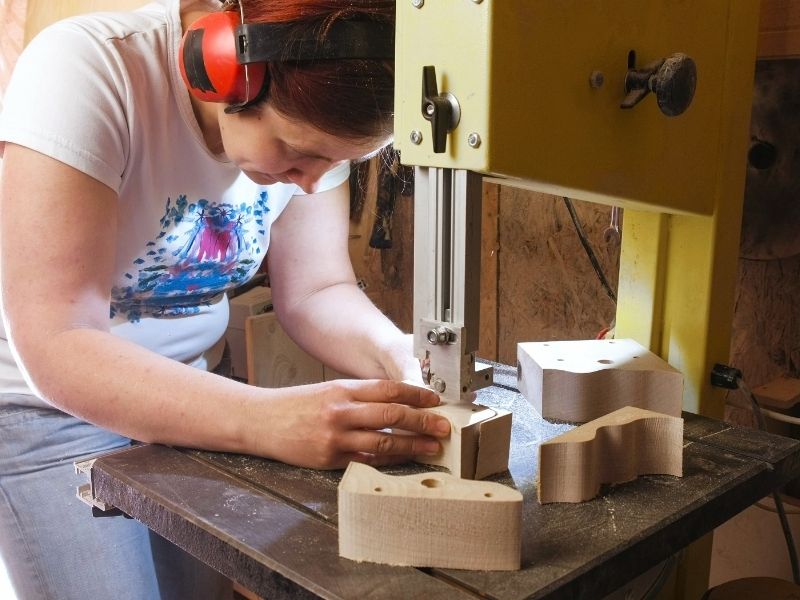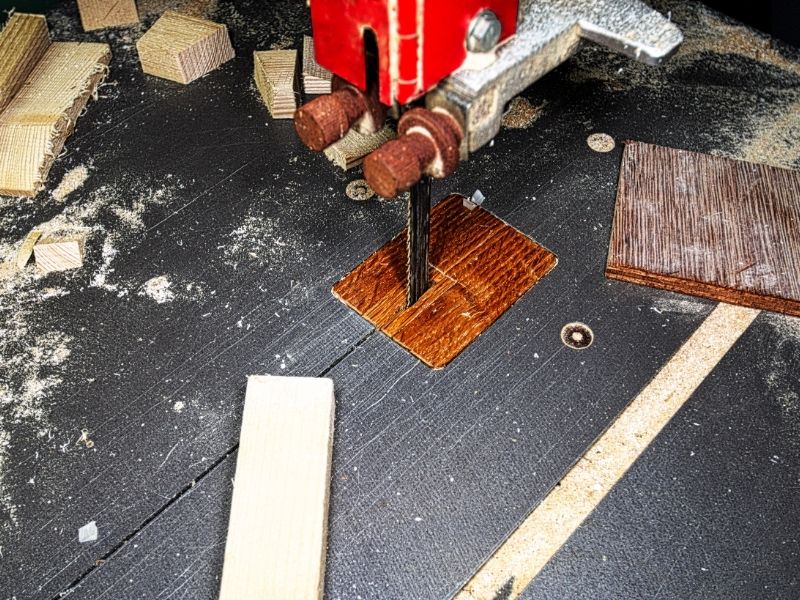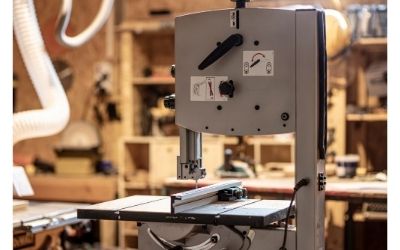
If you’re contemplating purchasing a band saw, you might be wondering, ‘what is a band saw used for?’ After all, they are not cheap items and probably not your first stationary power tool purchased for a shop. Regardless, it is versatile power tool and used skilfully, a quality bandsaw can be a game changer for a woodworker.
So what is a band saw used for?
A band saw can…….
- cut curves, even in thick lumber, such as in creating cabriole legs
- rip lumber and crosscut short pieces
- cut irregular shapes
- cut decorative mouldings and other furniture and cabinetry pieces.
- resaw or rip lumber into thinner slabs
- reset the edge of a board
- make veneer
- process small logs
- make smooth cuts in wood, metal, plastic and aluminum (with the correct blade in place)
Related: Best Bandsaw Blades for Resawing
How To Choose the Right Bandsaw…….
Bandsaws have a number of options and features you’ll need to consider before you purchase one. Features such as Power, Throat Capacity, Guide Wheels, Speed, Blade Guides, Fence, Precision, Dust Extraction and Bevel Capacity are the major components that affect the quality and durability of your machine. Hopefully this guide will assist you with knowing what to look out for so you can make the right investment for your needs.
- Power
Besides the blade, the power of your bandsaw’s motor is central to how effective it will be. While there might be plenty of models available with less than one horsepower, this grunt falls a bit short when it comes to resawing.
Most of the time, when resawing you tend to rip boards across its widest point. Therefore the saw will need more power than your typical bandsaw will provide.
As a general rule, with bandsaw motors, the more power the better. I would look for a saw with a minimum of a 1 horsepower although there are plenty with more than this including two-horsepower motors.
Also you’ll definitely need decent power for 14-inch bandsaws. Anything less than one horsepower and the saw will struggle to drive the blade through thick boards.
- Throat Capacity
Throat capacity refers to the size distance between the top blade guides and the saw table. A smaller band saw will have a limited throat capacity of 4 to 5 inches. This makes it not very useful for resawing purposes though. For example, if you wanted to create beautiful bookmatched cuts, you’ll need at least 8 inches or more throat capacity.
In this respect, throat capacity size is like horsepower – the more, the merrier! Most prefer a saw that can easily rip through a 10-inch board with ease. If your band saw does have a smallish throat capacity (like the 6″ Grizzly G0555LX reviewed above) you can get a riser kit to go with it to give it more height.

- Guide Wheels – Aluminium Versus Steel
Materials of the bandsaw’s wheels that drive the blade can definitely affect the saw’s performance. Science tells us that the heavier the wheel driving the blade, the more momentum and inertia from behind will drive the blade forward.
Hence the heavier the wheel behind the blade, the easier the cuts will be. Increased weight and heft provides greater impact than what lighter materials offer.
Generally bandsaw wheels can be either aluminum or cast iron. Aluminum of course is much lighter, and are therefore more likely used in cheaper saws. Cast iron wheels are heavier and are used in higher quality machines. Although they are more expensive, cast iron wheels are always the best option and will provide the greater durability and functionality.
Related: Best Bandsaws for Resawing
- Variable Speed
Any good quality power tool should have the ability to vary the speed. In a bandsaw when it comes to resawing, the slower cutting are always preferred. The reduced speed produces a steady cut.
Also, this method of cutting prevents the saw from binding, as it removes material with each pass. You can then switch back to a higher speeds when needed to produce faster, cleaner, and more precise cuts.
- Blade Guides
The guides are small rollers that sit on either side of the blade used to prevent movement. The purpose of the blade guide is to ensure that your blade is square to the table and true to prevent it from turning. Another feature, which prevents movement, is the thrust support pressed against the back of the bandsaw blade.
Here the thrust support restricts the blade from moving backwards during a cut.
We find that high-quality machines have two sets of blade guide, one above the saw table at the base of the blade guide enclosure, and one underneath the table. Basic machines often lack the bottom blade guide set.
Two types of blade guides are available for bandsaws; sealed bearings, or ceramics.
The bearing guide ones first appeared on the market and as such are easier to replace if need be. They are often more durable than their ceramic counterpart, even though ceramic are a more recent addition to blade guide market.
- Bandsaw Fence System
When it comes to resawing a fence is a must. A poor, dodgy fence will definitely yield poor, sad results! Trust me, they are worth their weight in gold. A tall one is essential for resawing – anything above four or five inches high. Otherwise, the material will tilt at the wrong moment and ruin your cut (plus a large portion of the material along with it!) Spend the extra money to get a taller fence and you’ll save some money on shipping by having it delivered with your saw.
The ideal bandsaw fence should be strong, stable, and sit square to the blade. Ideally, you want to be able to support as much of the piece as you can. So the fence should match the height of the timber you’re aiming to resaw.
If you find it difficult to get a tall fence (or would like one above 10 or 12 inches) try and find a design that has the option of attaching some t-tracks. This will allow you to fix a piece of ¾ inch plywood to it and give support to the wood you’re cutting.
You’ll also want to ensure you can lock the fence down securely to the table. Ensure the fence cinches down accordingly and doesn’t move at the back. It’s good if you can get a fence with a micro adjust feature which will let you dial in those precise cuts.

- Precision
Without a doubt, precision and accuracy are key to a good band saw. Nothing worse than dealing with blade drift from a blade that starts to cut slightly off square, then just stays that way. Super frustrating! To fix it you’ll have to make minor adjustments to the feed angle and this should correct the drift.
At times, cheaper models can suffer from significant blade drift. This makes them difficult for freehand cuts, and almost impossible to use for resaw cuts! A top quality bandsaw shouldn’t drift too much making using them a whole lot easier.
- Dust extraction
Dust extraction is an issue for all power tools that carve up wood. Even bandsaws – cheap or expensive! Generally, saws equipped with a 4-inch dust port below the table are much more efficient than those that house a 2 ½ dust port.
Above the table, extraction is far more complicated. Perhaps the best option is a posable arm that you could position close to the cut. Ideally, placing the suction directly above each cut will get rid of as much dust as possible.
- Bevel Capacity
Bevel capacity is crucial to more complex cuts like dovetails. It is so handy if you can securely and accurately set the saw table to the blade. It gives much greater versatility to your machine.
It is best to look for a bandsaw that can tilt at least 45 degrees or more for miter cuts. You’ll be glad you did.
- Extra Blades
It is worth noting that the blades you will use for ripping will have different teeth and thickness to the ones you’ll one for resawing (particularly on the thinner resaws). Perhaps pick out several blades that you can use for different purposes.
You may also want to consider a riser kit to extend the resaw capacity of your bandsaw. It really is one of the best investments you can make in your saw.
Final thoughts….
Now that you know more about the features of a band saw, check out our band saw reviews.

Thanks for sharing this article. This is really helpful article.
Hi Jose, you’re welcome. We thought so too!
I have no idea what you’re talking about….
But I mean that with the greatest respect.
I am completely DIY-shy so to speak… I can do the basics but really struggle with woodwork.
That’s why I’ve started learning and reading up what I can.. So just wanted to say thanks for putting this together.
Ha, ha…all good Shaun. It can be a bit daunting for sure. If you’re just starting out, you might want to go opt for a more straight forward power tool like a miter saw. Bandsaws are expensive but super useful for particular projects that you can’t do as well (if at all) with other tools. Happy to help!